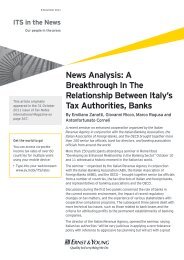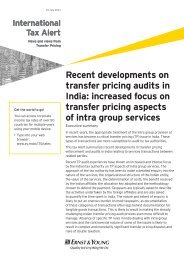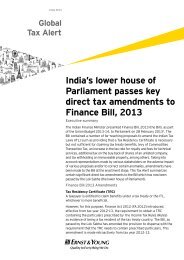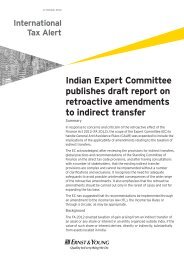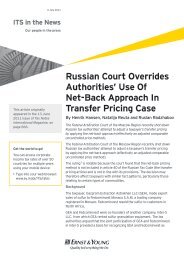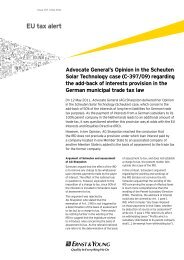(GST) compliance obligations (pdf, 5.62 MB) - Ernst & Young T ...
(GST) compliance obligations (pdf, 5.62 MB) - Ernst & Young T ...
(GST) compliance obligations (pdf, 5.62 MB) - Ernst & Young T ...
Create successful ePaper yourself
Turn your PDF publications into a flip-book with our unique Google optimized e-Paper software.
Insights<br />
Multiple invoices, multiple problems<br />
The VAT Director of an MNE operating in more than 100<br />
countries discusses the difficulty of adopting a standard VAT<br />
invoice globally:<br />
“Our mantra for efficient processes is ‘standardize, digitize,<br />
globalize.’ The issuance of a tax invoice is really the<br />
same process in every country. What changes is the data<br />
elements on those invoices. If you think practically about<br />
how you would make a VAT work, the tax invoice is a central<br />
document. We are familiar within our core markets in the<br />
EU, for example, that there is probably a list of, let’s say, 20<br />
things that go on at tax invoice. That is, the same 20 things<br />
in all the EU countries. We are seeking to compile that list<br />
the world over because if we can then see that it is really the<br />
same 20 things, we can then say ‘OK, if we build a generic<br />
invoice template, it is probably going to apply to the world<br />
over.’ ”<br />
“The exceptions to that of course are those countries where<br />
other laws and rules impinge on us. From a very narrow VAT<br />
Getting it right first time<br />
The Global VAT Director of a large financial institution<br />
comments on the practical difficulties that short reporting<br />
deadlines pose for complex organizations:<br />
“What would make my life easier? Longer filing periods. That<br />
would give us a better chance to get it right first time. Also<br />
a greater attempt by tax administrations to understand<br />
what their theoretical rules mean in practice for large<br />
VAT and <strong>GST</strong>: multiple burdens for multinational companies<br />
perspective, we could be equipped to issue that standard<br />
invoice out of a standard ERP or invoicing system and do<br />
it from one place centrally, efficiently and meet our global<br />
needs. However, the other sorts of laws that will catch you<br />
out are usually corporate laws, local accounting laws, local<br />
laws on books and records and local laws, let’s say, that<br />
invoices have to be signed or rubber stamped.”<br />
“We can issue the same commercial invoice in pretty well every<br />
country in the world. The contract terms of what would be<br />
billed, the currency, the frequency with which we will invoice<br />
— all that is agreed upfront. The bit that we are trying to<br />
then address is: how do you convert all that commercially<br />
agreed stuff into what the tax law or the bookkeeping law in<br />
the country actually requires? Supplier and customer know<br />
exactly what’s going on because that’s what they contracted.<br />
But how do the two parties then shoehorn that into their<br />
books and records such that it complies with the bookkeeping<br />
requirements of the local country concerned or the tax law?”<br />
organizations that want to pay the right amount of tax,<br />
with willingness to agree a pragmatic ‘Plan B’ where global<br />
accounting systems deliver accurate results but don’t fit<br />
exactly with local rules.”<br />
20





